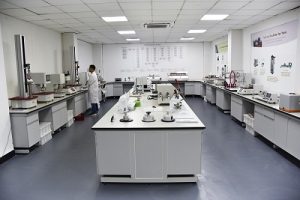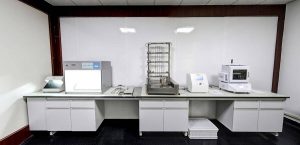Definition of Water Vapour Transmission (WVT) The mass of water vapour that passes, vertically, through…
How to Plan the Textile Test Laboratory?
To begin with, let’s talk about the design and plan of the overall laboratory.
As far as I’m concerned, what the whole lab need is nothing more than several rooms: a constant temperature and humidity laboratory, a ready room, a washing room, a sun-dried room, a hanging dry room, a darkroom, a reference room, and an office.
1 Constant Temperature and Humidity Laboratory: the setting value of temperature and humidity for textiles is generally as follows: temperature is 20±1℃, and the relative humidity is 65%±2%. The number of cycles of air flow is about 15 to 30 times per hour. The noise is lower than 55 decibels, and fresh air should be added. It is generally divided into three areas: the buffer room playing a buffer role to ensure the stability of temperature and humidity, the air-conditional room to ensure the circulation of air volume and reduce the impact of noise, and the constant temperature and humidity room whose door is not opened until the door of the buffer room is closed. The door should be immediately closed after opening, which ensures that the temperature and humidity do not vary greatly. So this aim can be achieved if the door is preferably made of steel plate door and the access control system is installed. The floor of the buffer room and air conditioning room in the drawings I design is usually made of composite flooring, which can save the cost of use and be beautiful. And anti-static floor of Red Sun is used on the ground of the laboratory, and micro-porous aluminum plate is used on the top. This is my little opinion about constant temperature and humidity laboratory. Your more advice is my best wishes.
 2 Ready Room: it is mainly a place to prepare before work. However, the area is generally not very small, because it is needed to be big enough to hold the clothes, cars, and test benches. Its floor is generally better with PVC flooring, and using tiles saves much. But it is necessary to use non-slip tiles. Microporous aluminum should be employed to decorate the top surface. Color steel plate — built-in rock wool is good at preventing fire — should be used to build the wall, which can also be brushed latex paint. The cost of both is almost the same, but the color steel plate is durable.
2 Ready Room: it is mainly a place to prepare before work. However, the area is generally not very small, because it is needed to be big enough to hold the clothes, cars, and test benches. Its floor is generally better with PVC flooring, and using tiles saves much. But it is necessary to use non-slip tiles. Microporous aluminum should be employed to decorate the top surface. Color steel plate — built-in rock wool is good at preventing fire — should be used to build the wall, which can also be brushed latex paint. The cost of both is almost the same, but the color steel plate is durable.
3 Washing Room: its floor is generally non-slip floor, and anti-slip tiles must be used. The wall is usually painted with latex. The best thing to do with water washing is to handle the water intake and drainage well, so there will be no water in the washing room. Separate power supply is needed for the washing room is also powerful.
4 Sun-dried Room: it is also relatively simple and cost-effective, with anti-slip tiles on the ground, micro-porous aluminum plate on the top and latex paint on the wall. There is usually a sun-dried instrument that simulates the sunlight. However, the sun-dryer needs ventilation, so ventilation should be considered in construction. And there’s also a hanger inside to hang clothes.
5 Hanging Dry Room: It is with anti-skid tiles on the floor, micro-porous aluminum plate on the top and latex paint on the wall. Inside the hanging room are some hangers. But one of my companies, they put ovens in it, if so we have to take the power of the power supply into consideration.
6 Darkroom: From my point of view, windows are not needed. In the front of darkroom need painting dark latex paint. The top surface is best to use the dark ceiling. The darkroom generally has a standard light source box—it is said that this instrument reflects the color contrast of cloth— which is placed on the test bench.

7 Reference Room: It is generally used to access the data. The sample cabinet is generally used. It is with ordinary ceramic tile on the ground, latex paint on the wall, and micro-porous aluminum plate on the top surface.
8 Office: It is with tiles on the floor, latex paint on the front of the office, and microporous aluminum plate on the top, which is the same as ordinary rooms. But the power socket in the room should be kindly considered, including power supply for computer, drinking water, and the air conditioning. File cabinets are usually needed. Conditions permitting, you can decorate the office with flower, plants, sofa and so on.
We know that the experimental environment, standard materials, testing instruments, measuring tools and human operations will all have an impact on the experimental results, and the standardization construction of the laboratory is to reduce the textile test error caused by the influence of external conditions. How can we avoid or reduce such errors in our practical work?
What has been mentioned above is my accumulated experience in the laboratory for so man years. It may be incomplete or wrong. But what I wish is that the fault can be corrected and the right can be shared with you. Welcome to leave messages and forward it.
Part of the above is reproduced in China Textile and Garment Forum.





This Post Has 0 Comments